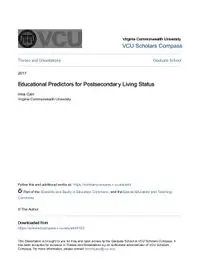
Educational Predictors for Postsecondary Living Status PDF
Preview Educational Predictors for Postsecondary Living Status
Virginia Commonwealth University VCU Scholars Compass Theses and Dissertations Graduate School 2017 Educational Predictors for Postsecondary Living Status Irina Cain Virginia Commonwealth University Follow this and additional works at: https://scholarscompass.vcu.edu/etd Part of the Disability and Equity in Education Commons, and the Special Education and Teaching Commons © The Author Downloaded from https://scholarscompass.vcu.edu/etd/4723 This Dissertation is brought to you for free and open access by the Graduate School at VCU Scholars Compass. It has been accepted for inclusion in Theses and Dissertations by an authorized administrator of VCU Scholars Compass. For more information, please contact © Irina Cain 2017 All Rights Reserved EDUCATIONAL PREDICTORS FOR POSTSECONDARY LIVING STATUS A dissertation submitted in partial fulfillment of the requirements for the degree of Doctor of Philosophy at Virginia Commonwealth University. by Irina Cain Bachelor of Arts, Alexandru Ioan Cuza University, 2006 Master of Education, University of Mary Washington, 2011 Director: Colleen Thoma, Ph.D. Professor and Chair Department of Counseling and Special Education Virginia Commonwealth University Richmond, Virginia April, 2017 Acknowledgement My dissertation topic is the result of interacting with people with disabilities and their families, after years of exploring different research avenues. I am forever grateful to my mentor, Colleen Thoma, who patiently allowed me to pursue these lines of research until I found one I felt truly passionate about, offered guidance along the way, and showed me more kindness and support than I ever thought possible. I am also grateful to my committee members who shaped the way I think about my topic and research in general. John Kregel and Michael Gamel-McCormick helped me situate my study in the larger historical, political, and conceptual contexts. Kevin Sutherland helped me think deeply about every decision I made along the development of my study, and putting the implications of my findings in context. Michael Broda helped me get excited about learning to use a new software package and provided easy to follow feedback and suggestions to make my study more rigorous. I would also like to thank Chin-Chih Chen, who introduced me to the intricacies of working with a large database and exposed me to new ways of thinking about research and teaching. I furthermore appreciate the conversations I had with fellow doctoral students about various methodologies and areas of research. Last but not least, I am grateful to my family for unwavering support through many life and career transitions. ii Dedication I would like to dedicate this dissertation to my daughter Iris. The message my work conveys is that everybody can achieve a life that reflects his or her values and wishes. I hope this might serve as an inspiration to you as you grow up to believe in your potential of becoming anything you set your mind to. iii Table of Contents List of Tables ............................................................................................................................... viii List of Figures ................................................................................................................................ ix ABSTRACT .................................................................................................................................... x I. INTRODUCTION ................................................................................................................... 1 1.1 Statement of Problem ................................................................................................... 2 Historical Progression of Research on Independent Living ....................... 4 Policy Addressing Residential Independence ............................................. 4 Benefits of Independent Living .................................................................. 5 1.2 Definition of Terms ...................................................................................................... 6 1.3 General Postsecondary Outcomes for Students with Disabilities ................................ 8 1.4 Independent Living as a Means of Asserting Choice ................................................ 10 1.5 Theoretical Framework .............................................................................................. 11 1.6 Methodology .............................................................................................................. 11 II. REVIEW OF LITERATURE ................................................................................................. 13 2.1 Conceptual Framework .............................................................................................. 13 2.2 Literature Selection ..................................................................................................... 16 2.3 Prevalence of Independent Living in the U.S. ............................................................ 17 2.4 Factors that Contribute to Better Independent Living Outcomes ............................... 19 2.4.1 Contextual Factors ....................................................................................... 19 iv Individual Characteristics ......................................................................... 19 Functional and Adaptive Skill Level ........................................................ 22 Student Leadership in Transition Planning ............................................... 25 Self-determination ..................................................................................... 25 Expectations, Perceptions, and Culture .................................................... 26 Health and Nutrition ................................................................................. 27 2.4.2 Curriculum and Services .............................................................................. 27 Direct Interventions .................................................................................. 29 Instruction in Simulated Environments .................................................... 31 Learning in the Community ...................................................................... 33 2.5 Literature Review Implications ................................................................................... 35 2.6 Study Implications ..................................................................................................... 38 2.7 Summary ..................................................................................................................... 39 III. METHODOLOGY ................................................................................................................ 41 3.1 Research Questions .................................................................................................... 41 3.2 Population .................................................................................................................. 41 Sampling Method ...................................................................................... 41 Data Collection Instruments ..................................................................... 44 Participants ................................................................................................ 44 3.3 Variables .................................................................................................................... 45 3.4 Analytic Procedures ................................................................................................... 47 Complex Sampling Procedures ................................................................. 47 Missing Data ............................................................................................. 47 v Data Analysis ............................................................................................ 54 Assumptions Check .................................................................................. 55 Variables Treatment .................................................................................. 58 Model Building ......................................................................................... 58 Interpretation ............................................................................................. 60 Moderation ................................................................................................ 61 3.5 Summary of Methodology ......................................................................................... 62 IV. RESULTS ............................................................................................................................... 63 4.1 Predictors .................................................................................................................... 64 4.1.1 Individual Characteristics ............................................................................ 64 4.1.2 Skills ............................................................................................................ 65 4.1.3 Family Factors ............................................................................................. 66 4.1.4 School Factors .............................................................................................. 67 4.1.5 Assessing the Model .................................................................................... 69 4.2 Moderators .................................................................................................................... 71 4.2.1 Ethnicity as Moderator ................................................................................. 71 4.2.2 Disability Label as Moderator ..................................................................... 75 4.2.3 Skills as Moderators ..................................................................................... 78 4.2.4 Family Factors as Moderators ...................................................................... 81 4.2.5 School Factors as Moderators ...................................................................... 81 4.3 Summary of Findings .................................................................................................. 83 V. DISCUSSION ......................................................................................................................... 84 5.1 Key Findings ............................................................................................................... 84 vi 5.2 Limitations .................................................................................................................. 95 5.3 Implications for Future Research ................................................................................ 95 5.4 Implications for Policy ................................................................................................ 98 5.5 Implications for Practice ............................................................................................. 98 5.6 Conclusion .................................................................................................................. 99 LIST OF REFERENCES ........................................................................................................... 101 APPENDICES: ........................................................................................................................... 127 Appendix A: Interventions for Increasing Life Skills ..................................................... 127 Appendix B: Variable Description .................................................................................. 135 Appendix C: Subpopulation Count ................................................................................. 139 VITA .......................................................................................................................................... 141 vii List of Tables 1. Data Collection Schedule ...................................................................................................... 43 2. Individual Characteristics Missingness ................................................................................. 48 3. Skills Missingness ................................................................................................................ 49 4. Family Factors Missingness .................................................................................................. 50 5. School Factors Missingness .................................................................................................. 51 6. Outcome Missingness ........................................................................................................... 52 7. Test of Independence Between Missing and Non-Missing Data .......................................... 53 8. Collinearity Statistics ............................................................................................................ 57 9. Logistic Regression Results .................................................................................................. 69 10. Link Test Results .................................................................................................................. 71 11. Interactions with Ethnicity .................................................................................................... 74 12. Interactions with Disability Label ........................................................................................ 77 13. Interactions with Skills ........................................................................................................ 81 14. Interactions with Family Factors ......................................................................................... 83 15. Parental Involvement X Independent Living ........................................................................ 89 viii
